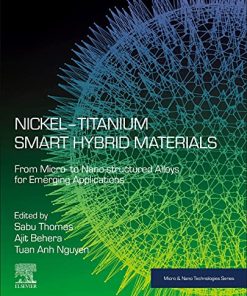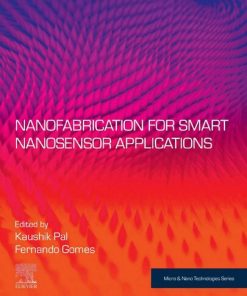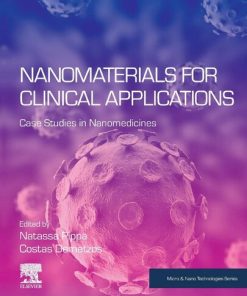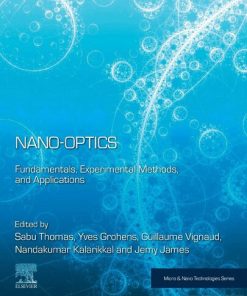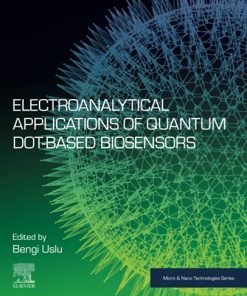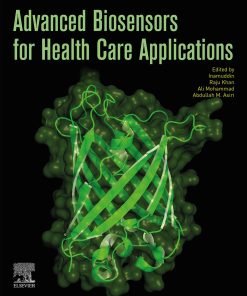(Ebook PDF) Nano inspired Biosensors for Protein Assay with Clinical Applications 1st Edition by Genxi Li 0128150548 9780128150542 full chapters
$50.00 Original price was: $50.00.$25.00Current price is: $25.00.
Nano-inspired Biosensors for Protein Assay with Clinical Applications 1st Edition by Genxi Li – Ebook PDF Instant Download/DeliveryISBN: 0128150548, 9780128150542
Full dowload Nano-inspired Biosensors for Protein Assay with Clinical Applications 1st edition after payment.

Product details:
ISBN-10 : 0128150548
ISBN-13 : 9780128150542
Author: Genxi Li
Nano-inspired Biosensors for Protein Assay with Clinical Applications introduces the latest developments in nano-inspired biosensing, helping readers understand both the fundamentals and frontiers in this rapidly advancing field. In recent decades, there has been increased interest in nano-inspired biosensors for clinical application. Proteins, e.g. antigen-antibody, tumor markers and enzymes are the most important target in disease diagnosis, and a variety of biosensing techniques and strategies have been developed for protein assay. This book brings together all the current literature on the most recent advances of protein analysis and new methodologies in designing new kinds of biosensors for clinical diagnostic use.
Nano-inspired Biosensors for Protein Assay with Clinical Applications 1st Table of contents:
Part I: Nanomaterials for Protein Assay
Chapter 1. Carbon Nanomaterials
Abstract
1.1 Introduction
1.2 Fullerene
1.3 Graphene and Graphene Oxide
1.4 Carbon Nanotubes
1.5 Conclusion
References
Chapter 2. Metal Nanomaterials
Abstract
2.1 Introduction
2.2 Nucleic Acid-Functionalized Metal Nanomaterials for Protein Assays
2.3 Surface Plasmon Resonance Featured Metal Nanomaterials for Protein Assays
2.4 Surface-Enhanced Raman Scattering-Based Protein Assays
2.5 Enzyme-Controlled MNMs Growth for Colorimetric Detection of Proteins
2.6 Natural Enzyme Activity Mimicking-Based Protein Assays
2.7 Conclusion
References
Further Reading
Chapter 3. Quantum Dots and Nanoclusters
Abstract
3.1 Quantum Dots
3.2 Nanoclusters
3.3 Conclusions
References
Further Reading
Chapter 4. Other Nanomaterials
Abstract
4.1 Introduction
4.2 Silicon Nanomaterials
4.3 Upconversion Nanomaterials
4.4 Liposome
4.5 Virus Nanoparticles
4.6 Conclusions
References
Further Reading
Part II: Molecular Recognition in Protein Assay
Chapter 5. Immuno-Biosensor
Abstract
5.1 Cancer Diagnostics and Monitoring
5.2 Tuberculosis Diagnostics and Monitoring
5.3 Diabetes Diagnostics and Monitoring
5.4 Human Immunodeficiency Virus (HIV)
5.5 Urinary Tract Infection Diagnosis
5.6 Pregnancy Screening
5.7 Conclusion
References
Chapter 6. Aptasensors
Abstract
6.1 Sandwich Aptasensor
6.2 Assay Based on Aptamer Conformational Switch
6.3 Assay Based on Competitive Binding of Target With Aptamer
6.4 Split-Type Assay
6.5 Assay Based on Aptamer–Cell Interaction
6.6 Conclusion
References
Chapter 7. Peptide-Based Biosensors
Abstract
7.1 Biosensors Based on the Binding of Peptide to Target
7.2 Biosensors Based on Cleavage of the Peptide
7.3 Biosensors Based on the Conformational Shift of Peptide
7.4 Conclusion
References
Chapter 8. Protein Assay Based on Protein–Small Molecule Interaction
Abstract
8.1 Protein Assay Based on Small Molecule-Tethered Chemical Probes
8.2 Protein Assay Based on Small Molecule-Linked DNA
8.3 Conclusion
References
Part III: Biosensing Technologies for Protein Assay
Part III: Biosensing Technologies for Protein Assay
Chapter 9. Electrochemistry
Abstract
9.1 Introduction
9.2 Electrochemical Techniques
9.3 Electrochemical Biosensors
9.4 Summary and Prospects
References
Further Reading
Chapter 10. Spectrometry
Abstract
10.1 Colorimetry
10.2 Fluorescence
10.3 Chemiluminescence
10.4 Electrochemiluminescence
10.5 Surface Plasmon Resonance Assay
10.6 Surface-Enhanced Raman Scattering
10.7 Dynamic Light Scattering Signal-Readout
10.8 Conclusion
References
Further Reading
Chapter 11. Other Signal-Readout Technologies
Abstract
11.1 Distance Signal-Readout
11.2 Pressure Signal-Readout
11.3 Piezoelectric Biosensors
11.4 Magnetic Signal-Readout
11.5 Smell Signal-Readout
References
Chapter 12. Signal Amplification
Abstract
12.1 Introduction
12.2 Nucleic Acid-Based Signal Amplification
12.3 Enzyme-Based Signal Amplification
12.4 “1-to-N” Binding-Based Signal Amplification
12.5 Conclusion
People also search for Nano-inspired Biosensors for Protein Assay with Clinical Applications 1st:
nanopore protein detection
nanobit assay promega
nanosens innovations
what are optical biosensors
what is biosensors in biotechnology
You may also like…
Medicine - Molecular Medicine
Uncategorized
Technique - Nanotechnology
Engineering - Bioengineering
Engineering
Chemical, Gas, and Biosensors for Internet of Things and Related Applications Kohji Mitsubayashi




